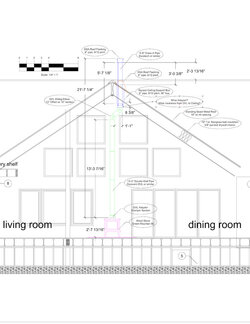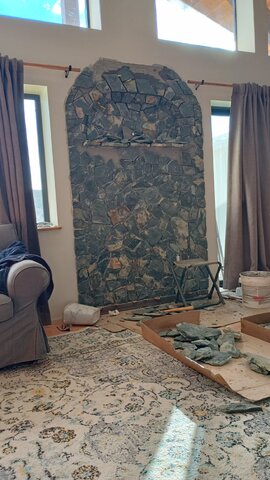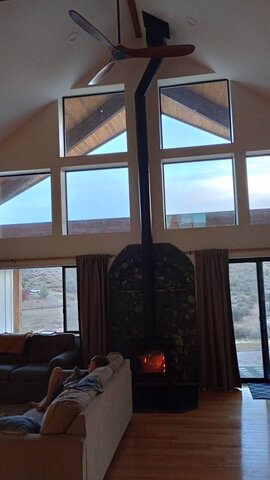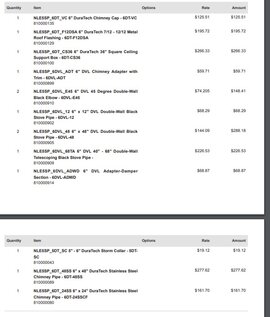Hi All,
I just purchased a Green Mountain 60 wood stove to put in my great room and have some first time installer confusion. Attached is a drawing that shows the setup I'm planning on. My questions are as follows:
1. I'm confused about the connection between the DVL and the ceiling support box. The drawing I found in the documentation shows it has some sort of an adapter protruding from the bottom but all the pictures I see of the box for sale I don't. Best I can tell I need the "DLV Adapter (6DVL-ADT) or do I need something else?
2. I assume my transition between DVL pipe and Class A Duratech pipe is at the bottom of the ceiling box via that "DLV Adapter". So then I just need to make sure this junction is at least 8" away from my ceiling per the 8" ceiling clearance spec for the DLV (since the pipe is coming up at an angle vs vertical) or something else. Also does it look like there is enough room in my drawing for the connection to keep this clearance?
3. As far as I can tell by reading the documentation, by using the ceiling support box there is no other structural support for the stove or chimney pipe other than the "DLV Adapter" junction between DVL and Class A pipe at the bottom of the box. Do I really not need any more support for the chimney pipe other than this for less than 5' above the roofline? I guess the roof flashing above and the stove connection below will stabilize it but it seems like it would need more.
4. If there is a more foolproof way of doing the flashing than tucking the uphill side under the ridge cap please say so. Roof penetrations make me nervous.
Of course I'm open to any other critique to my plan. I like to do things correct the first time. Thanks in advance.
-Adam

I just purchased a Green Mountain 60 wood stove to put in my great room and have some first time installer confusion. Attached is a drawing that shows the setup I'm planning on. My questions are as follows:
1. I'm confused about the connection between the DVL and the ceiling support box. The drawing I found in the documentation shows it has some sort of an adapter protruding from the bottom but all the pictures I see of the box for sale I don't. Best I can tell I need the "DLV Adapter (6DVL-ADT) or do I need something else?
2. I assume my transition between DVL pipe and Class A Duratech pipe is at the bottom of the ceiling box via that "DLV Adapter". So then I just need to make sure this junction is at least 8" away from my ceiling per the 8" ceiling clearance spec for the DLV (since the pipe is coming up at an angle vs vertical) or something else. Also does it look like there is enough room in my drawing for the connection to keep this clearance?
3. As far as I can tell by reading the documentation, by using the ceiling support box there is no other structural support for the stove or chimney pipe other than the "DLV Adapter" junction between DVL and Class A pipe at the bottom of the box. Do I really not need any more support for the chimney pipe other than this for less than 5' above the roofline? I guess the roof flashing above and the stove connection below will stabilize it but it seems like it would need more.
4. If there is a more foolproof way of doing the flashing than tucking the uphill side under the ridge cap please say so. Roof penetrations make me nervous.
Of course I'm open to any other critique to my plan. I like to do things correct the first time. Thanks in advance.
-Adam





